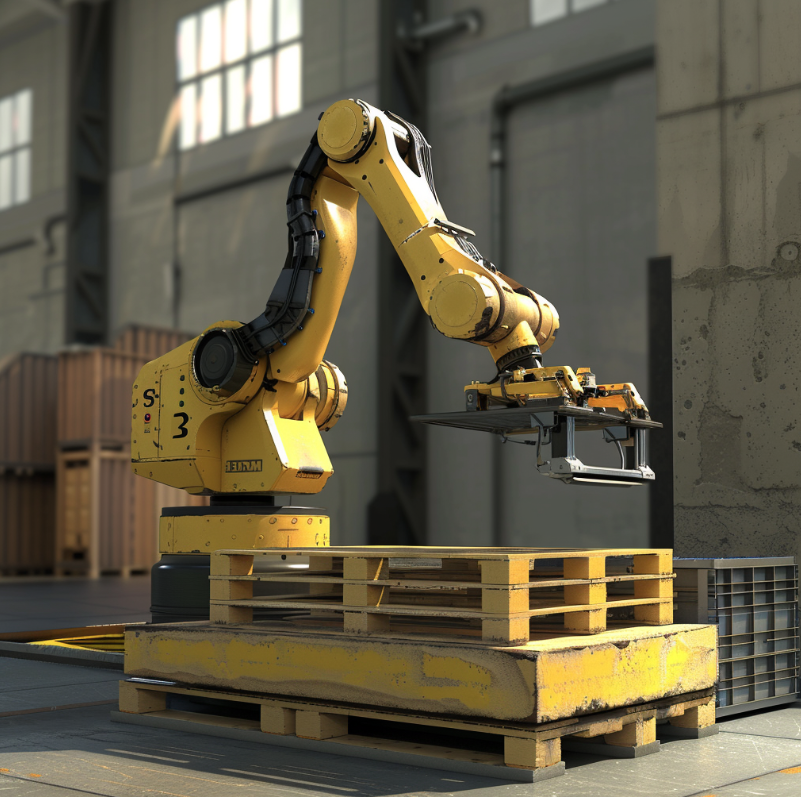

Robot Palletizing systems use robotic arms to automatically stack and organize products onto pallets for shipping and storage.
These robo-systems pick up individual items, cases, or bundles and place them onto pallets in a pre-programmed pattern.
Robot Palletizers can handle payloads from a few pounds up to thousands of pounds. They’re high speed, high accuracy, and high consistency for stacking all types of items.
So, how do robot Palletizing systems work their magic?
Let’s find out:
Even though we may think of a robot Palletizing system as just the part that picks up and drops things, many small parts work their magic together.
They are:
The cost of a robot Palletizing system can vary a huge deal depending on the components and complexity.
You’ll need to budget for the Palletizing robot arm, end-of-arm tooling like grippers, safety equipment, integration services, and any additional conveyors or pallet dispensers.
Here’s a detailed breakdown:
Note: Robot Palletizing systems often recoup their cost within 1-3 years due to increased efficiency and productivity.

Robot Palletizing systems are a big upfront cost, but they can save you money and boost efficiency in the long run.
Once installed, these systems require minimal maintenance and no wages or benefits. Meaning, they can work 24 hours a day, 7 days a week without breaks.
Robot Palletizers also improve safety by eliminating risks like back strains (ow!), crushed fingers, and accidents from forklifts. Their precise and repetitive movements practically guarantee stable, neatly stacked pallets every time.
This reduces product damage and the risk of pallets toppling over.
Also, production speeds and throughput will increase significantly with a robot on the job. A single robot can typically palletize up to 6,000 cases per hour, far outpacing human workers.
Plus, their consistently high speeds and ability to work continuously allow manufacturers to boost output without adding extra shifts.
Already, robot Palletizing systems are showing how they’re faster, smarter, and more affordable than ever before.
And these systems are the creme de la creme, the best-of-the-best robot Palletizing systems on the market right now:
It’s versatile, integrates seamlessly with various tools, and is priced more attractively than rivals (50% less!). Plus, its cutting-edge AI and safety features make it a team-friendly option for any Palletizing task.
Want to learn more? Head to our top 3 case Palletizing robots article to go in-depth!
Programming a robot Palletizing system has become much easier in recent years with intuitive software interfaces and simulation tools. Most manufacturers offer drag-and-drop programming that allows you to simply demonstrate the desired Palletizing motion. Their software will then automatically generate the proper code to execute that motion. ]
Some even offer pre-programmed Palletizing routines that you can easily customize for your needs. These Offline programming tools let you program and test the system without interrupting your production line.
Absolutely. Robot Palletizing systems can handle mixed product Palletizing with ease. Their flexible programming allows them to pick and place products of various shapes, sizes, and weights. Vision guidance or conveyor tracking is often used to identify and orient the products properly.
The robot can then build stable, intermixed pallets. Some systems can even apply custom Palletizing patterns for the most efficient, stable pallet build possible for your unique product mix. Mixed Palletizing is a perfect application for robot Palletizers.
Robot Palletizing systems are designed to minimize floor space requirements. A typical system needs only about 10 to 30 square feet of floor space for the robot, controller, conveyors, and safety guarding.
The exact space depends on the payload and reach required for your Palletizing needs. Compared to traditional Palletizing methods, robot Palletizing systems offer a very compact, space-efficient solution. They can easily fit into existing production lines and facilities.
By now, you should have a strong understanding of robot Palletizing systems - how they work, what they're made of, and whether investing in one is worth it for your business.
But, as we hope to have made abundantly clear, not all robot Palletizing systems are made equal. We’ve helped shorten your search to the best three, but you’ll have to determine your purchase by assessing:
That’s why we’ve taken the liberty of choosing a robot in each price bracket: low-budget, cost-effective, and high-price.
The rest, as they say, is up to you.